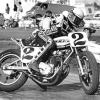I've often wondered what the answer to this might be - just what would be the quickest racing car ever built, that had no intentional downforce generating elements fitted to it? My first thought would be the Lotus 49 (pre B version, or even pre-Spa '67 that had the front air deflectors fitted) but would there be anything else out there that would have been quicker over a lap?
There are probably multiple answers, as something like a GT40 mk1 (did it have a swept up rear tail to try and generate some downforce?) would have been probably quicker at Le Mans than the 49, and vice versa at Silverstone, for example. Or a Lotus 72 with no wings fitted, assuming the tub / body shape wasn't designed with any intention other than to be as slippery as possible.
What do others think? Have I missed a late 60's / early 70's mechanical grip-only machine out there somewhere? ![]()






















